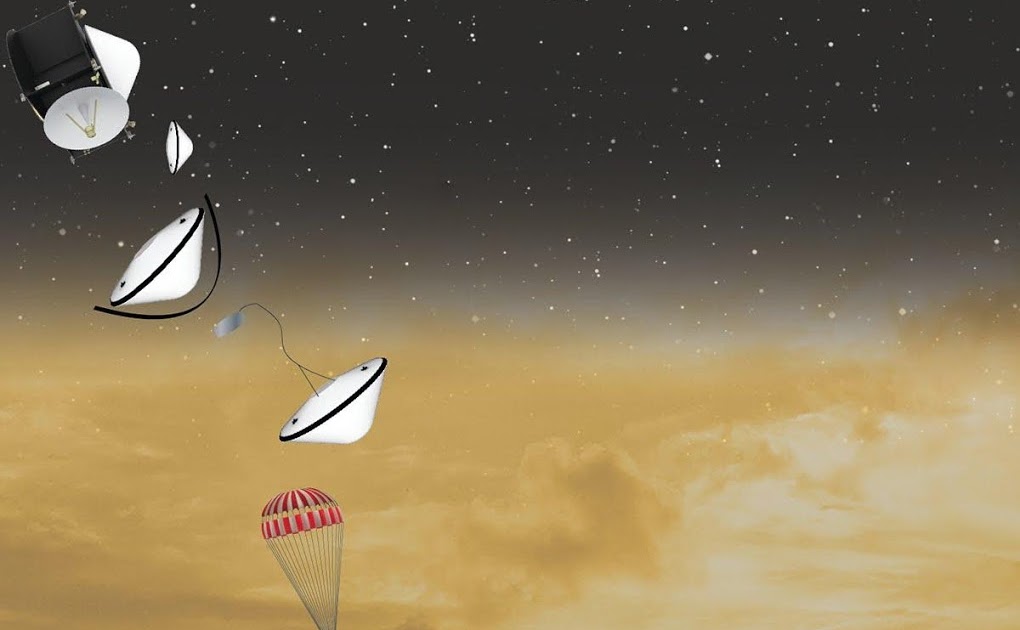By Allison Kubo Hutchison
NASA announced on June 2 that it would send two missions to the hot house planet. Once again NASA made robots will vist the Venusian skies for the first time since the Magellen orbiter mission which ended in 1994. These missions come after renewed interest in Venus due to the hotly debated phosphine controversy which if true could be a biosignature. The two missions were selected as part of the Discovery Program after a competitive peer review against the other possible missions. The two lucky winners are the DAVINCI+ (Deep Atmosphere Venus Investigation of Noble gases, Chemistry, and Imaging) and VERITAS (Venus Emissivity, Radio Science, InSAR, Topography, and Spectroscopy).
DAVINCI+, led by James Garvin of Goddard Space Flight Center, will measure the composition of Venus’ atmosphere with the goal of understanding how it was formed (Pictured). It would be the first U.S.-led mission to sample and study the atmosphere since 1978 and the first probe to study the atmosphere since the Soviet space probes Vega 1 & 2 in 1984. DAVINCI+ will launch into the atmosphere which will sample the gases during its descent and relay their composition and isotopic makeup. As it races toward the surface, DAVINCI+ will work on returning high resolution images of the “tesserae”, mysterious terrain across Venus which has puzzled geologists since Magellen.
The second mission, VERITAS, led by Suzanne Smrekar of NASA’s Jet Propulsion Laboratory, will update and upgrade the maps taken by Magellen. It will record the surface elevations over __ of the planet. Using a method called synthetic aperture radar, the probe will be able to map the surface with high fidelity that was previously unavailable. With this new data, planetary scientists hope to study whether or not Venus has plate tectonics like it’s neighbor. This study may also illuminate how plate tectonics began on our own planet. Venus’ hot atmosphere has allowed the crust to retain hot temperatures similar to early Earth and may show how the crust cracked and formed tectonic plates. VERTITAS will also start mapping Venus in infrared. In the infrared spectrum, we will be able to differentiate different rock types and minerals. In addition, it will be able to detect volcanic activity when hot water vapor is released into the atmosphere.
Each of the two missions was awarded $500 million and will jumpstart Venus science for the first time in 30 years. They are expected to launch in 2028-2030.
The second mission, VERITAS, led by Suzanne Smrekar of NASA’s Jet Propulsion Laboratory, will update and upgrade the maps taken by Magellen. It will record the surface elevations over __ of the planet. Using a method called synthetic aperture radar, the probe will be able to map the surface with high fidelity that was previously unavailable. With this new data, planetary scientists hope to study whether or not Venus has plate tectonics like it’s neighbor. This study may also illuminate how plate tectonics began on our own planet. Venus’ hot atmosphere has allowed the crust to retain hot temperatures similar to early Earth and may show how the crust cracked and formed tectonic plates. VERTITAS will also start mapping Venus in infrared. In the infrared spectrum, we will be able to differentiate different rock types and minerals. In addition, it will be able to detect volcanic activity when hot water vapor is released into the atmosphere.
Each of the two missions was awarded $500 million and will jumpstart Venus science for the first time in 30 years. They are expected to launch in 2028-2030.
What happens when several thousand distinguished physicists, researchers, and students descend on the nation’s gambling capital for a conference? The answer is “a bad week for the casino”—but you’d never guess why.
Lexie and Xavier, from Orlando, FL want to know: “What’s going on in this video ? Our science teacher claims that the pain comes from a small electrical shock, but we believe that this is due to the absorption of light. Please help us resolve this dispute!”
Even though it’s been a warm couple of months already, it’s officially summer. A delicious, science-filled way to beat the heat? Making homemade ice cream. (We’ve since updated this article to include the science behind vegan ice cream. To learn more about ice cream science, check out The Science of Ice Cream, Redux ) Image Credit: St0rmz via Flickr Over at Physics@Home there’s an easy recipe for homemade ice cream. But what kind of milk should you use to make ice cream? And do you really need to chill the ice cream base before making it? Why do ice cream recipes always call for salt on ice?

